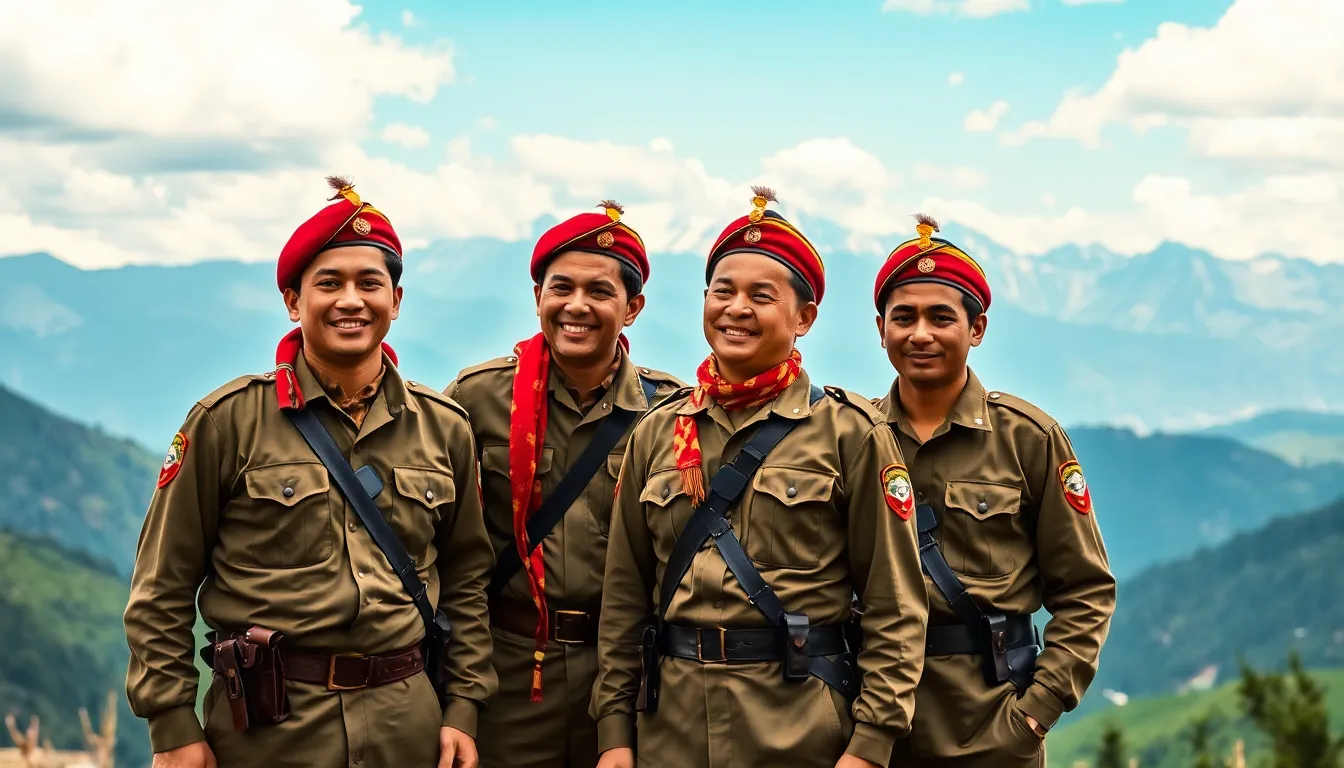In a world filled with epic tales and legendary warriors, few stories capture the imagination quite like that of the “nepalkrigare.” These fearless fighters from Nepal have a reputation that precedes them, blending bravery, skill, and a dash of humor that keeps their enemies on their toes. If you think you’ve heard it all about warriors, think again.
From their stunning mountain landscapes to their rich cultural heritage, Nepal has birthed some of the most formidable soldiers in history. But what makes these warriors truly unique? It’s not just their prowess in battle; it’s their incredible spirit and resilience that shine through. Buckle up as we dive into the fascinating world of nepalkrigare, where courage meets camaraderie, and every battle tells a story worth sharing.
Table of Contents
ToggleOverview of Nepalkrigare
Nepalkrigare refers to the legendary warriors of Nepal, recognized for their courage and exceptional combat skills. These soldiers emerge from a rich cultural history that embodies the spirit of Nepal’s diverse communities. Known for their unique sense of humor, they often blend tactical prowess with lightheartedness even during intense situations.
The Gurkhas, a prominent part of the nepalkrigare legacy, have garnered worldwide respect. They are primarily known for their loyalty and discipline, traits that define their character in battle. Historical accounts note their participation in significant conflicts, showcasing their effectiveness and feared reputation.
Notably, these warriors possess a deep connection to the land of Nepal. Majestic mountains, lush valleys, and vibrant traditions shape their identity and instill pride in their heritage. Each aspect of Nepal’s landscape serves as a backdrop for the challenges they face, adding authenticity to their stories.
Additionally, camaraderie among nepalkrigare significantly enhances their effectiveness as a fighting unit. Relationships forged in battle foster unity and resilience, allowing them to confront adversity together. Legends of their exploits continue to inspire admiration across cultures.
The essence of nepalkrigare goes beyond warfare. Their tales reflect principles of honor, bravery, and the relentless pursuit of justice. Each story serves as a testament to their unwavering commitment to their comrades and country, solidifying their place in history as remarkable warriors.
Historical Background

The historical significance of nepalkrigare, notably the Gurkhas, is rooted in a legacy of valor. These legendary warriors emerged from the rugged terrain of Nepal, shaping their identities and skills.
Origins of Nepalkrigare
Origins trace back to the early 19th century when the British sought skilled fighters in the region. Gurkhas, recognized for their bravery and combat proficiency, quickly gained a reputation. Nepal’s unique geography, characterized by towering mountains and challenging landscapes, influenced their development as formidable soldiers. Cultural heritage played a vital role, as traditions of honor and loyalty permeated their training. Nepalkrigare embody the spirit of resilience, underscoring their connection to their homeland.
Key Historical Events
Significant events underscore the prominence of nepalkrigare throughout history. The Anglo-Nepalese War in 1814 marked a turning point, spotlighting their military effectiveness. Subsequently, Gurkhas participated in various global conflicts, including both World Wars. Recognition came from allied forces, appreciating their unwavering loyalty and fighting spirit. Notable battles, like the Battle of Haifa in 1918, showcased their courage and skill, further establishing their valor. These warriors contributed to the global battlefield while maintaining a deep connection to their Nepalese roots.
Cultural Significance
The cultural significance of nepalkrigare extends beyond their military prowess. Their legacy influences various aspects of Nepalese culture and identity.
Representation in Literature and Art
Numerous works of literature and art depict nepalkrigare, celebrating their bravery and honor. Stories, poems, and paintings often highlight their heroism in battle. Artists and writers capture the essence of their spirit, showcasing their resilience against adversity. Traditional Nepalese narratives frequently illustrate the valiant acts of these warriors, intertwining history with cultural values. Each creative representation enhances the collective memory, honoring their contributions to society.
Modern Interpretations
Modern interpretations of nepalkrigare continue to evolve, reflecting contemporary perspectives. Films and documentaries illuminate their experiences, providing newer generations insight into their dedication and sacrifices. Through these mediums, audiences connect with the profound honor and courage displayed by nepalkrigare. Current events and discussions often bring their legacy into focus, reminding many of their importance in both national and international contexts. As interpretations grow and adapt, the spirit of nepalkrigare remains a symbol of strength and loyalty.
Impact on Society
The impact of nepalkrigare extends deeply into various societal layers, influencing political stability and social perspectives in Nepal.
Political Ramifications
Nepalkrigare play significant roles in shaping Nepal’s political landscape. Their historical service in the British Army influences relationships between Nepal and other nations, enhancing diplomatic ties. Military achievements of nepalkrigare often bolster national pride, fostering a sense of unity among citizens. When decisions regarding defense policies arise, the contributions of these warriors typically prompt discussions about military tradition. They embody resilience, showcasing Nepal’s strategic military heritage during international negotiations and peacekeeping missions. Their reputation for loyalty strengthens the trust between the government and the military, leading to increased investment in the armed forces. Military parades and ceremonies honoring nepalkrigare reflect the enduring legacy and influence on national identity.
Social Perspectives
Society holds nepalkrigare in high esteem, viewing them as symbols of courage and sacrifice. Their bravery inspires narratives in Nepalese culture, weaving tales of heroism into everyday life. Iconic figures from their history become cultural icons, elevating the national spirit. Community events often feature tributes to nepalkrigare, reinforcing their importance in collective memory. Stories of valor and loyalty resonate with the youth, instilling values of honor and discipline. Social media platforms frequently highlight their achievements, fostering pride and respect among younger generations. The reverence for these warriors also contributes to a deeper understanding of cultural heritage, bridging connections between past and present.
Challenges and Controversies
Challenges faced by nepalkrigare often stem from their long-standing traditions and modern military integration. Loyalty to their historical values sometimes clashes with new expectations in contemporary military roles. Differing perspectives on their contributions lead to controversies regarding their status and recognition, both within Nepal and internationally.
The recruitment process for nepalkrigare can present difficulties. Nepal’s limited resources challenge the ability to adequately train and equip soldiers. Cultural adjustments are also necessary as they adapt to different military environments outside Nepal. These factors may undermine morale among recruits, complicating the mission readiness of units.
Discussions around the treatment of nepalkrigare after service spark debate. Veterans sometimes encounter difficulties accessing military benefits, creating frustration among former soldiers. Reports of inadequacies in healthcare and support systems have emerged, raising concerns within the veteran community. Advocacy for improved policies and benefits remains critical for those who served.
Narratives around nepalkrigare contributions in global conflicts often reflect a romanticized view, overshadowing complex realities. The glorification of battle stories can detract from the harsh experiences faced by soldiers. In addition, issues of representation arise within portrayals in media and literature, which may not accurately reflect the diverse experiences of nepalkrigare.
Engaging in peacekeeping missions has its own challenges for nepalkrigare. Balancing their reputation for combat readiness with diplomatic roles often leads to conflicting expectations. Questions about their effectiveness in non-combat scenarios further complicate perceptions of their capabilities. This ongoing discourse underscores the need to recognize and address the multifaceted nature of their contributions and experiences.
The legacy of nepalkrigare transcends mere military prowess. Their stories embody the spirit of Nepal’s rich culture and history, showcasing resilience and camaraderie that resonate deeply within society. As modern challenges arise, the need to honor their contributions while addressing their realities becomes increasingly vital.
The nepalkrigare’s influence continues to shape Nepalese identity, inspiring future generations with tales of bravery and honor. Their journey reflects a commitment to values that extend beyond the battlefield, reminding everyone of the importance of loyalty, sacrifice, and cultural pride.



